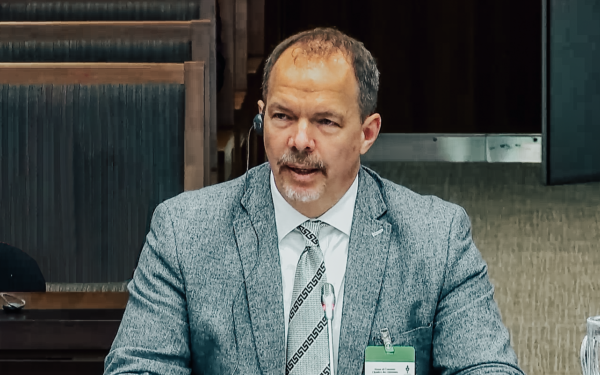CIRA is embarking on the fifth year of its Community Investment Program. Canadian not-for-profits, charities and researchers doing good things for and through the internet can apply for a CIRA grant during the application period, which launches on January 15th. To celebrate the program’s success, we are sharing stories of past recipients who have inspired us through their contribution to building a better online Canada. Read part three of the series: Capturing culture and history online, Lesser Slave Lake.
Part 3: LSLIRC-TARR Web Research & Archive Portal
CIRA is embarking on the fifth year of its Community Investment Program. Canadian not-for-profits, charities and researchers doing good things for and through the internet can apply for a CIRA grant during the application period, which launches on January 15th. To celebrate the program’s success, we are sharing stories of past recipients who have inspired us.
In 2014, the Lesser Slave Lake Indian Regional Council Treaty and Aboriginal Rights Research Program (LSLIRC−TARR) received a grant on behalf of CIRA’s Community Investment Program to create a web portal that functions as a centralized accessible online resource for rural First Nation communities in Alberta. The purpose of this project was to assist in treaty interpretation, social advocacy, historical claims, and genealogical research.
Since the website launched in October 2014, the Council has had several requests for assistance in putting on local events in the Lesser Slave Lake area using materials identified on the website. Students from across Canada have also reached out for help with research projects. Without the website, these interactions would not be possible.
We sat down with Morgan Chapman, a member of the LSLIRC−TARR team, to learn more about the impact of the Community Investment Program in developing this project.
How did you hear about CIRA and the Community Investment Program?
We often look for grant opportunities to support the work we do for our seven member Nations. As we were doing our usual scan in 2014, we came across CIRA and the Community Investment Program.
We were going through a period of transition and as we did, we recognized that a public web portal would highlight the unique set of records we house and offer our communities a way to engage with our research team.
How important was CIRA’s grant for your project’s success?
CIRA’s grant was integral to the development of the LSLIRC-TARR Program & Archives website. The grant supported research for our seven member Nations. Without the support and funding received from CIRA, it’s safe to say we would not have the web presence we have today.
Since launching our website, we’ve had a broad range of requests from members of the communities we provide research and archival services to, and from students across Canada who are starting to learn about the numbered treaties signed across Canada. Our communities are signatories to 1899’s Treaty No. 8 and we’ve included research resources on our website highlighting the importance of the Treaty and the promises made to signatories contained within it.
What were some of the highlights of your project?
The highlight of our project was creating a dynamic web presence for our program and archive. It’s one thing for our member Nations to know we exist, but to be available to researchers across Canada has been important. Drawing on existing relationships with web developers made during the design and build phase of our website, our archive has been made aware of other grant opportunities. As a result, we’ve completed many very important projects to protect and preserve our materials for our communities.
What were some of the challenges?
One of our largest challenges was putting over 100 years of history into a consumable format for the public. We represent seven diverse communities in the Lesser Slave Lake region in Northern Alberta and provide information on other Treaty No. 8 signatory Nations within Alberta on our website. We continue to update our published materials to best reflect the varied histories in Alberta, while also focusing on keeping our archival database up to date. It is a large undertaking, but one we are excited to continue to meet head-on.
How does your project contribute to a better online Canada?
Canada is a diverse country and our website and archival database helps showcase a different perspective of the country. We were the first accredited archival institution that is wholly owned and managed by First Nations within the Archives Society of Alberta (ASA), and we may still be the only such accredited institution in Alberta. It is important for us to protect and preserve the materials we have, and when possible, make Canadians aware of the important history we maintain on-site. In the context of Prime Minister Trudeau’s continued commitment to advance Canada’s national reconciliation agenda, we hope that our website, and its associated resources, can play a meaningful part in educating Canadians about First Nations’ unique relationship with the Crown.
What advice would you give organizations considering applying for a grant?
Pick a project you are passionate about – be clear in your objectives and be flexible. You will likely need to alter direction as your collective vision and needs change.
For us, undertaking this project was no small feat – we had many other large projects tied into making our website launch a success. It was a lot of work, but I think we are all extremely pleased with the outcome. The time involved in completing the grant has been more than worthwhile for us.
About CIRA’s Community Investment Program
CIRA is building a better online Canada through the Community Investment Program by funding innovative projects led by charities, not-for-profits and academic institutions that are making the internet better for all Canadians. CIRA is best known for our role managing the .CA domain on behalf of all Canadians. While this remains our primary mandate, as a member-based not-for-profit ourselves, we have a much broader goal to strengthen Canada’s internet. The Community Investment Program is one of our most valuable contributions toward this goal and funds projects in infrastructure, digital literacy, research and online services. Every .CA domain name registered or renewed contributes to this program. To date, CIRA has supported 102 projects with over $4.2 million in contributions. The application period for funding opens on January 15th. Visit www.cira.ca/cip to learn more.
Mackenzie Messenger specializes in corporate communications for CIRA. She has a passion for branding, internal communications and organizational learning. She also has a Master of Arts in Organizational Communication from the University of Ottawa, where she conducted research on millennials in the workplace.




